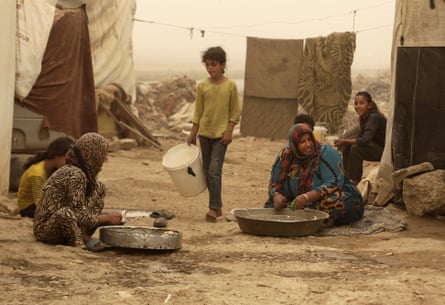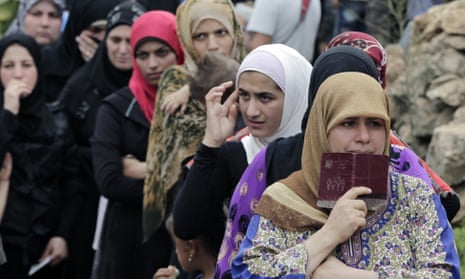Conditions for Syrian refugees in the Middle East are so dire that some are now considering returning to their war-ravaged homeland rather than endure poverty, hunger and a futureless exile in the neighbouring nations where they are stranded, the UN has warned.
Some refugees have been reduced to begging on the streets of the Jordanian capital, Amman, or selling flowers and living rough in Lebanon, aid workers say.
They also warn that the European anxieties over a new influx are misplaced as most refugees do not have the means to make the long and expensive journey.
The World Food Programme (WFP) – which has been forced to halve its assistance to almost 1.3 million vulnerable Syrian refugees in the region because of a $341m funding shortfall – said it feared some would try to go home as they now feel they have a better chance back in their own ruined country than sitting it out in Jordan or Lebanon.
More than four million Syrians have fled their country since the civil war erupted in 2011, with most settling in Jordan, Lebanon, Turkey, Iraq and Egypt.
“A few years ago, refugees arriving in Jordan and Lebanon would tell me that they were certain that they would go back in a few weeks or months,” said Dina El-Kassaby, a WFP spokeswoman.
“But the people here are telling us that they would go back to Syria – back to an active warzone. That must mean that they have really reached rock bottom to make that choice.”
El-Kassaby said that the latest food voucher cuts – which have left most refugees living on around 50 cents a day – were “the straw that broke the camel’s back”.
She added: “It’s not like they got their food assistance cut and decided, ‘OK, that’s it. I’m leaving.’ This is several years of struggle and systematically finding, month-by-month, that forms of assistance are being cut off. And now the one that has lasted the longest – food assistance – is one that we just can’t keep up any longer unfortunately.”
Although most of the poorest and most vulnerable refugees living in camps around the region are still receiving full rations through the voucher scheme, those in host communities are struggling harder than ever before, said El-Kassaby.
“Almost all refugees report coping with the cuts by eating cheaper food and skipping meals, but many people are taking their children out of school and sending them to work,” she said.
“We are now seeing people begging at traffic lights in Amman. That’s not something we saw a few years ago. People are working for much lower wages than they should be because they need to get by.”
El-Kassaby said that with their savings and assets long since exhausted and tensions rising with host communities, refugees were facing a terrible choice.
“Many people are in deep debt with neighbours and landlords and food voucher cuts are now kind of the trigger for people to think: ‘I’m not even receiving food. I’m not receiving cash assistance from other organisations. Nobody’s helping me to put my children in school and there’s no hope for me or my children here. Maybe I should go back to Syria or try my luck abroad’. That’s the tone I’m hearing from people.”
However, she dismissed suggestions that the dire circumstances in the countries that host the Syrian refugees would force many of them to head for Europe. In Jordan, she said, some were too poor to cover the cost of the 90-minute road journey from Amman to the border with Syria.
“It’s a bit dangerous to link the movement to Europe strictly with reductions in assistance because we are assisting those who are most vulnerable and who don’t have the money to buy their own meal – let alone a journey to Europe,” she said.
Anecdotal evidence from the UN refugee agency, UNHCR, suggests that many of those now fleeing Syria are increasingly aware of the situation in Lebanon and Jordan – both of which have tightened up entry restrictions – and so are attempting to head to Europe instead.
Melissa Fleming, UNHCR’s chief spokesperson, said “significant numbers” of refugees were trying to come to Europe straight from Syria rather than settling in its neighbours.
“One of the reasons is that they can’t stay in Lebanon,” she said. “If you can show a plane ticket when you get to the border with Lebanon, you can cross. Otherwise, you can’t. They have imposed some quite strict restrictions now on refugees entering. They will accept exceptional humanitarian cases but without a plane ticket somewhere else, you’re probably not going to get in. It’s difficult to get into Jordan, too, so people leaving Syria now are choosing not to remain in the neighbouring countries.”
With the UNHCR’s $4.5bn Syria appeal only 37% funded, said Fleming, the agency was struggling to help relieve the pressure on host countries, leading them to become less tolerant of having so many refugees. That, in turn, was affecting the Syrians they have taken in.
“Refugees are saying, ‘I can tolerate that my child is out of school for two years, working in the fields to support the family, but three years? Four years? Are we ever going to go back? No’.”
She added: “It’s reached a kind of tipping point both with the refugees and the host countries.”
With Lebanon now hosting more than a million Syrian refugees – who now constitute a fifth of the population – the strains are becoming increasingly apparent. The country has almost reached its projected population level for 2050.

Syrian children walk the streets of Beirut, selling flowers, shining shoes or begging, sleeping rough at night and often abused by drunk bar patrons or bystanders.
In the agricultural Bekaa Valley, many live in cantons of plastic tents that collapse in the harsh winter, and toil in the fields for little pay. The government has long dithered on building refugee camps, unlike in Turkey and Jordan, leaving an inevitable humanitarian crisis to grow, and many families are going hungry, left with just $13 a month per person for food in handouts from the WFP.
The electricity in the Shatila camp in south Beirut, originally set up for Palestinian refugees in 1949, comes on for about two hours a day and the tap water is a salty liquid. Its population swelled and poverty intensified in late 2012 after thousands of Palestinians living in Syria fled to Lebanon when their neighbourhood in Damascus, Yarmouk, became subject to airstrikes by the regime of Bashar al-Assad.
Since the new visa rules were introduced by the Lebanese government earlier this year, the number of new refugees registering with the UNHCR has dropped by 75% despite the continuing ferocity of the Syrian war.
Mohammad, a Palestinian-Syrian who fled Damascus, is keen to leave the camp and make for Europe by travelling illegally from the northern port city of Tripoli to Turkey.
“It’s the best of the bad choices,” he said. “The next 10 or 15 years will pass, and you have to do something for your life.”
Mohammad had already booked his passage to Turkey, but the boat was turned back at the last minute. Now he searches for another – everyone in the camps knows someone who can help smuggle them out, everyone has phone numbers, he said.
“You can’t work and no country will ever give you a visa,” he said. “I’m just waiting for the first chance.”
Until there is enough money to shore up the infrastructures of host countries and improve the lives and prospects of their refugee populations, said Fleming, “people are going to continue to leave and head for Europe”.
Although much of the focus has been on refugees risking their lives to cross the Mediterranean, the UN is keen to remind the world of the plight of those still trapped in a seemingly endless conflict in their homeland.
“We also have millions of children inside Syria that we shouldn’t forget about,” said Juliette Touma, a spokeswoman for the UN children’s agency, Unicef.
“We currently have more than 5.6 million children who need assistance – some of them displaced internally, sometimes multiple times – and some of them are caught in the line of fire or are living under siege.”
